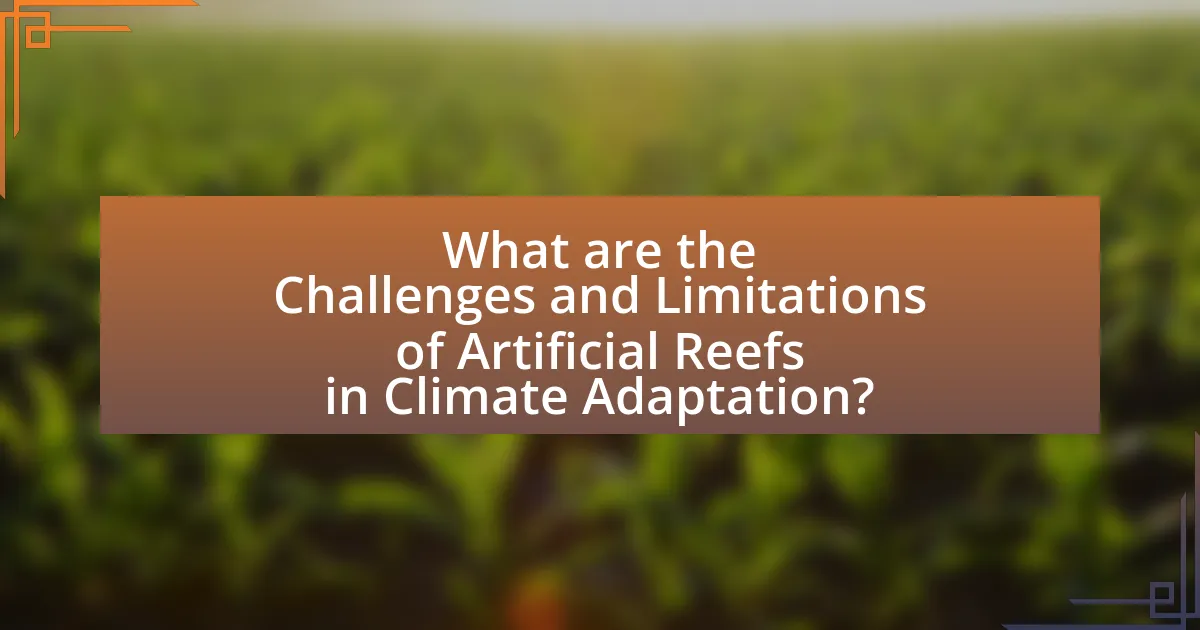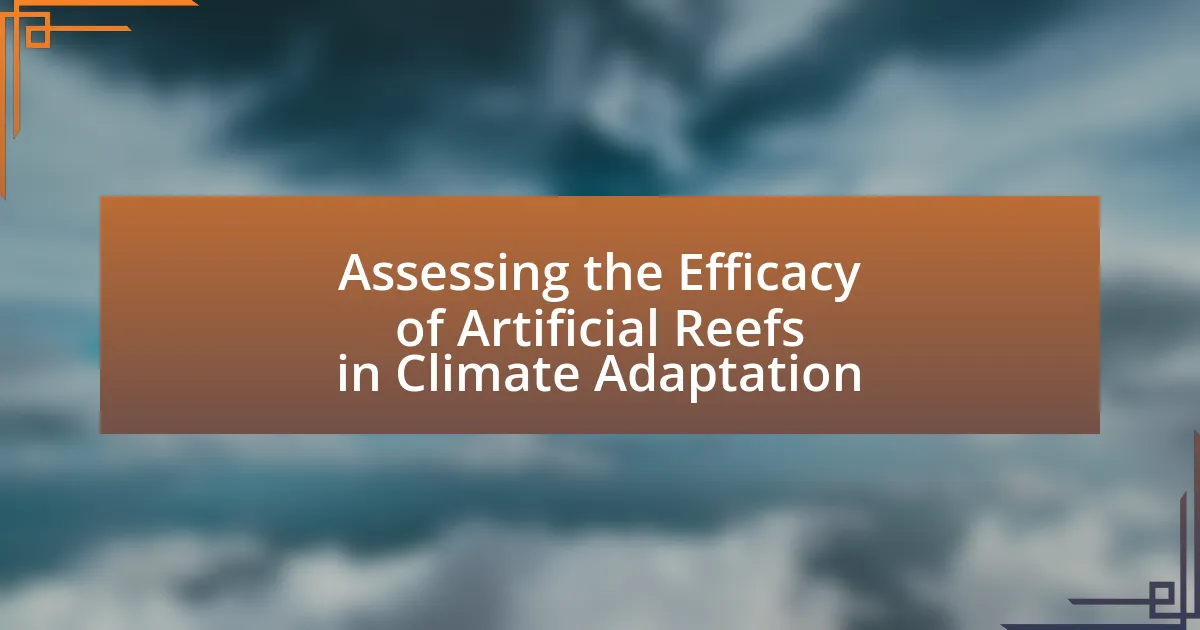Artificial reefs are man-made structures designed to enhance marine biodiversity and serve as critical habitats for various marine species. This article examines the role of artificial reefs in climate adaptation, highlighting their effectiveness in mitigating climate change impacts, supporting fisheries, and providing coastal protection. Key topics include the materials used in their construction, methods for assessing their efficacy, and the challenges they face in local ecosystems. Additionally, the article discusses innovative designs and community involvement as strategies to improve the success of artificial reefs in promoting ecological resilience.

What are Artificial Reefs and Their Role in Climate Adaptation?
Artificial reefs are man-made structures placed in marine environments to promote marine life and enhance biodiversity. They serve as critical habitats for various species, which can help bolster fish populations and improve ecosystem resilience. In the context of climate adaptation, artificial reefs can mitigate the impacts of climate change by providing shelter and breeding grounds for marine organisms, thereby supporting fisheries and enhancing coastal protection against erosion and storm surges. Research indicates that artificial reefs can increase local biodiversity by up to 50%, demonstrating their effectiveness in fostering marine ecosystems that are more resilient to climate-related changes.
How do artificial reefs function in marine ecosystems?
Artificial reefs function in marine ecosystems by providing structured habitats that enhance biodiversity and support marine life. These structures attract various species, including fish, invertebrates, and corals, which utilize the reefs for shelter, breeding, and feeding. Research indicates that artificial reefs can increase local fish populations by up to 50% compared to surrounding areas, as they create new environments that mimic natural habitats. Additionally, they can help mitigate coastal erosion and promote the recovery of overfished species, contributing to the overall health of marine ecosystems.
What materials are commonly used to construct artificial reefs?
Common materials used to construct artificial reefs include concrete, steel, and natural materials like rock and coral. Concrete is favored for its durability and ability to support marine life, while steel structures provide stability and longevity in marine environments. Natural materials, such as rock and coral, are often used to enhance biodiversity and mimic natural habitats. Research indicates that these materials effectively promote marine ecosystems, as evidenced by studies showing increased fish populations and biodiversity around artificial reefs made from these substances.
How do artificial reefs support marine biodiversity?
Artificial reefs support marine biodiversity by providing structured habitats that enhance the growth and survival of various marine species. These structures create new environments for fish, invertebrates, and other marine organisms, facilitating increased species richness and abundance. Research indicates that artificial reefs can attract a diverse array of marine life, including commercially important fish species, thereby contributing to local fisheries and ecosystem health. For instance, a study published in the journal “Marine Ecology Progress Series” found that artificial reefs can increase fish biomass by up to 50% compared to natural habitats, demonstrating their effectiveness in promoting marine biodiversity.
Why are artificial reefs considered a strategy for climate adaptation?
Artificial reefs are considered a strategy for climate adaptation because they enhance marine biodiversity and provide habitat for fish and other marine organisms, which can help ecosystems recover from climate-related stressors. Research indicates that artificial reefs can mitigate the impacts of ocean acidification and rising sea temperatures by offering stable environments for marine life. For instance, studies have shown that artificial reefs can increase fish populations by up to 50%, thereby supporting local fisheries and enhancing food security in coastal communities. This ecological resilience is crucial as climate change continues to threaten natural habitats.
What specific climate challenges do artificial reefs address?
Artificial reefs address specific climate challenges such as coastal erosion, habitat loss, and declining marine biodiversity. By providing structured environments, artificial reefs stabilize shorelines and reduce the impact of wave energy, thereby mitigating coastal erosion. Additionally, they create new habitats for marine species, which counteracts the loss of natural reefs due to climate change and human activities. Studies have shown that artificial reefs can enhance local biodiversity, with some reports indicating increases in fish populations by up to 200% in areas where they are deployed.
How do artificial reefs contribute to coastal protection?
Artificial reefs contribute to coastal protection by reducing wave energy and mitigating coastal erosion. These structures dissipate the force of incoming waves, which helps to protect shorelines from the impact of storms and high-energy surf. Research indicates that artificial reefs can lower wave heights by up to 50%, significantly decreasing the potential for erosion and damage to coastal infrastructure. Additionally, they promote sediment accumulation, which further stabilizes the shoreline and enhances habitat for marine life, thereby supporting biodiversity and ecosystem resilience.

What are the Methods for Assessing the Efficacy of Artificial Reefs?
The methods for assessing the efficacy of artificial reefs include ecological monitoring, fishery yield analysis, and biodiversity assessments. Ecological monitoring involves tracking changes in species composition and abundance over time, which provides insights into the reef’s role in habitat enhancement. Fishery yield analysis evaluates the economic benefits derived from increased fish populations associated with artificial reefs, demonstrating their impact on local fisheries. Biodiversity assessments measure the variety of species present, indicating the reef’s effectiveness in promoting marine life. These methods collectively provide a comprehensive understanding of how artificial reefs contribute to marine ecosystems and fisheries.
What metrics are used to evaluate the success of artificial reefs?
Metrics used to evaluate the success of artificial reefs include biodiversity, fish biomass, and habitat complexity. Biodiversity is measured by the variety and abundance of species that inhabit the reef, indicating ecological health. Fish biomass quantifies the total weight of fish present, reflecting the reef’s ability to support marine life. Habitat complexity assesses the structural features of the reef, which influence species diversity and abundance. Studies have shown that successful artificial reefs can increase local fish populations by up to 50% and enhance biodiversity by providing essential habitats for various marine organisms.
How is biodiversity measured around artificial reefs?
Biodiversity around artificial reefs is measured using various ecological metrics, including species richness, abundance, and diversity indices. Researchers often conduct underwater surveys and utilize techniques such as visual census, quadrat sampling, and remote sensing to collect data on the number of species present and their population sizes. Studies have shown that artificial reefs can enhance local biodiversity by providing habitat complexity and shelter, which supports a greater variety of marine life. For instance, a study published in the journal “Marine Ecology Progress Series” found that artificial reefs can increase fish species richness by up to 50% compared to natural habitats.
What role does fish population monitoring play in assessment?
Fish population monitoring is crucial for assessing the health and sustainability of marine ecosystems, particularly in the context of artificial reefs. This monitoring provides data on species diversity, abundance, and biomass, which are essential for evaluating the effectiveness of artificial reefs in enhancing fish habitats and supporting biodiversity. Studies have shown that artificial reefs can significantly increase fish populations by providing shelter and breeding grounds, thus contributing to overall ecosystem resilience against climate change. For instance, research published in the journal “Marine Ecology Progress Series” indicates that artificial reefs can lead to a 30% increase in fish biomass compared to natural habitats, underscoring the importance of ongoing monitoring to inform management practices and conservation strategies.
How do researchers collect data on artificial reefs?
Researchers collect data on artificial reefs primarily through underwater surveys, remote sensing, and monitoring technologies. Underwater surveys involve divers or remotely operated vehicles (ROVs) assessing biodiversity, fish populations, and habitat structure. Remote sensing techniques, such as satellite imagery and sonar mapping, provide spatial data on reef distribution and changes over time. Additionally, monitoring technologies like acoustic tags and underwater cameras help track species movement and behavior around the reefs. These methods collectively enable researchers to evaluate the ecological impacts and effectiveness of artificial reefs in enhancing marine biodiversity and resilience to climate change.
What technologies are employed in the monitoring process?
The technologies employed in the monitoring process of artificial reefs include remote sensing, underwater video systems, and acoustic monitoring. Remote sensing utilizes satellite imagery and aerial photography to assess reef health and changes over time. Underwater video systems, such as ROVs (remotely operated vehicles), provide real-time visual data on marine life and structural integrity. Acoustic monitoring employs hydrophones to track fish populations and their behaviors, offering insights into the ecological impact of artificial reefs. These technologies collectively enhance the understanding of artificial reefs’ roles in climate adaptation by providing accurate, real-time data on their effectiveness and ecological contributions.
How do field studies contribute to understanding artificial reef efficacy?
Field studies significantly enhance the understanding of artificial reef efficacy by providing empirical data on their ecological impacts and benefits. These studies allow researchers to observe real-world interactions between marine organisms and artificial structures, revealing patterns of biodiversity, species recruitment, and habitat utilization. For instance, a study conducted by B. R. S. Smith et al. in 2020 demonstrated that artificial reefs can increase fish abundance by up to 50% compared to natural habitats, highlighting their role in supporting marine life. Additionally, field studies facilitate long-term monitoring, enabling scientists to assess changes over time and evaluate the effectiveness of different reef designs in promoting resilience against climate change.

What are the Challenges and Limitations of Artificial Reefs in Climate Adaptation?
Artificial reefs face several challenges and limitations in climate adaptation, primarily including ecological impacts, structural integrity, and maintenance issues. Ecologically, artificial reefs can disrupt local marine ecosystems by attracting non-native species, which may outcompete native organisms, leading to biodiversity loss. Structural integrity is a concern as these reefs can degrade over time due to harsh marine conditions, limiting their effectiveness as habitats. Additionally, maintenance challenges arise from the need for regular monitoring and repairs, which can be resource-intensive and costly. Studies indicate that without proper management, the intended benefits of artificial reefs may not be realized, highlighting the need for comprehensive planning and ongoing assessment to ensure their role in climate adaptation is effective.
What environmental factors can affect the performance of artificial reefs?
Environmental factors that can affect the performance of artificial reefs include water temperature, salinity, wave energy, sedimentation rates, and nutrient availability. Water temperature influences the metabolic rates of marine organisms, impacting growth and reproduction. Salinity variations can affect species composition and survival rates of reef inhabitants. Wave energy affects the structural integrity of the reef and the organisms that can inhabit it, with higher energy potentially leading to erosion. Sedimentation rates can smother reef organisms, reducing biodiversity and habitat complexity. Nutrient availability can influence algal growth, which in turn affects the entire ecosystem associated with the reef. These factors collectively determine the ecological success and sustainability of artificial reefs in marine environments.
How do ocean currents and sedimentation impact artificial reefs?
Ocean currents and sedimentation significantly influence the structure and ecological success of artificial reefs. Ocean currents can transport nutrients and larvae, enhancing biodiversity and promoting the growth of marine organisms on the reefs. Conversely, strong currents may lead to erosion or displacement of the reef materials, compromising their integrity. Sedimentation can either benefit artificial reefs by providing a substrate for organisms to attach to or hinder their effectiveness by smothering marine life and reducing light penetration. Studies indicate that optimal sedimentation rates are crucial; excessive sediment can lead to decreased biodiversity and reef health, while moderate levels can support growth. For instance, research published in the journal “Marine Ecology Progress Series” highlights that artificial reefs in areas with balanced sedimentation and favorable currents exhibit higher rates of colonization and species diversity.
What are the potential negative impacts of artificial reefs on local ecosystems?
Artificial reefs can negatively impact local ecosystems by altering natural habitats, introducing invasive species, and disrupting existing marine life. The introduction of artificial structures can change water flow and sediment patterns, which may lead to habitat degradation for native species. Additionally, artificial reefs can attract non-native species that outcompete local organisms for resources, thereby threatening biodiversity. Studies have shown that these changes can result in a decline in native fish populations and overall ecosystem health, as evidenced by research conducted by the National Oceanic and Atmospheric Administration, which highlights the ecological risks associated with artificial reef deployment.
How can the design of artificial reefs be improved for better efficacy?
The design of artificial reefs can be improved for better efficacy by incorporating diverse materials and structures that enhance habitat complexity. Research indicates that using a variety of substrates, such as concrete, steel, and natural materials, increases biodiversity and attracts a wider range of marine species. For example, a study published in the journal “Marine Ecology Progress Series” found that reefs with varied topography and surface textures supported 30% more fish species compared to uniform structures. Additionally, optimizing the placement and orientation of artificial reefs to align with natural currents and local ecosystems can further enhance their effectiveness in promoting marine life and resilience against climate change impacts.
What innovative materials or designs are being explored?
Innovative materials being explored for artificial reefs include bio-concrete, which incorporates natural materials to enhance marine life colonization, and recycled plastics, which reduce waste while providing structural integrity. Research indicates that bio-concrete can improve the growth rates of coral and other marine organisms, as demonstrated in studies by the University of California, which found that coral growth on bio-concrete was significantly higher compared to traditional materials. Additionally, designs incorporating modular structures allow for adaptability and scalability, facilitating easier installation and maintenance. These advancements aim to enhance the ecological benefits of artificial reefs while addressing environmental sustainability.
How can community involvement enhance the success of artificial reefs?
Community involvement can enhance the success of artificial reefs by fostering local stewardship and increasing awareness of marine conservation. Engaged communities are more likely to participate in monitoring and maintenance efforts, which can lead to better ecological outcomes. For instance, studies have shown that areas with active community participation in reef management report higher biodiversity and improved fish populations. Additionally, local knowledge can inform the design and placement of artificial reefs, ensuring they meet ecological needs and community goals. This collaborative approach not only strengthens the ecological integrity of artificial reefs but also promotes sustainable fishing practices and enhances community resilience against climate change impacts.
What best practices should be followed when implementing artificial reefs?
Best practices for implementing artificial reefs include selecting appropriate materials, ensuring structural integrity, and conducting thorough site assessments. Using environmentally friendly materials, such as concrete or natural substrates, minimizes ecological impact and promotes marine life colonization. Structural integrity is crucial; reefs must withstand environmental forces like currents and storms to remain effective. Site assessments should evaluate local marine ecosystems, ensuring that the artificial reef enhances biodiversity without disrupting existing habitats. Research indicates that well-planned artificial reefs can increase fish populations and improve habitat complexity, supporting overall marine health.
